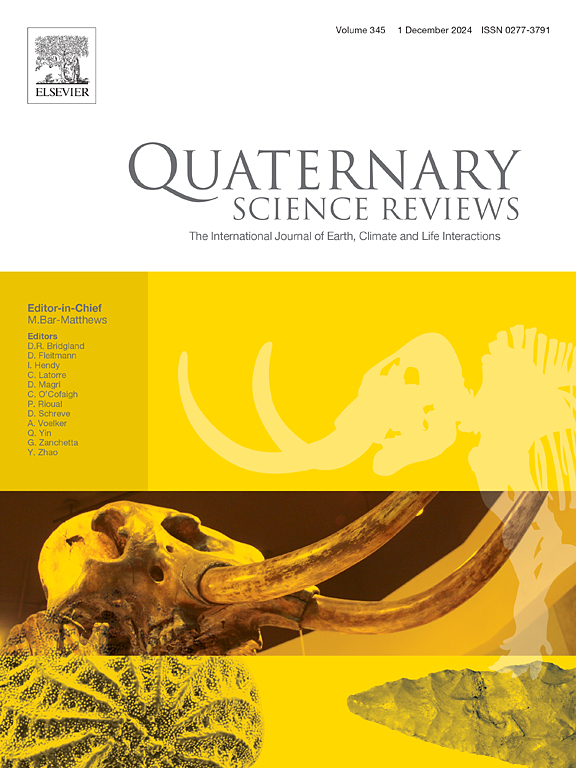Late-Holocene hydrological cycling in the maritime Ross Sea in response to the El Niño-Southern Oscillation
IF 3.3
1区 地球科学
Q1 GEOGRAPHY, PHYSICAL
引用次数: 0
Abstract
Hydrological dynamics in Antarctic coastal ice-free regions are an important part of climate variability that is crucial for terrestrial ecosystems in Antarctica. However, there is no geological record of hydrological changes in lakes in the Ross Sea region. Here we used analyses of surface lake sediment and living microbial mats to show that photoautotrophic organism-derived lipid hydrogen isotopes reflected the δ2H values of lake water (δ2Hwater). We present a new record of δ2Hlipids from two lacustrine sediment cores collected from Inexpressible Island in the western Ross Sea to reconstruct δ2Hwater values over the past 3000 years. The reconstructed δ2Hwater values range from −103 to −35 ‰, and are significantly higher than δ2Hwater values of precipitation (snow). On the basis of our modern observations, the slope of the linear regression between δ2H and δ18O in lake water is lower than both global and Antarctic meteoric water lines, suggesting strong lake evaporation at our study region. Our sensitivity modeling experiment showed that the strength of evaporation is closely linked with summer air temperature. Furthermore, δ2Hlipids showed similar patterns in variations with regional air temperature recorded by ice cores in the western Ross Sea, indicating that lake surface evaporation is mainly driven by air temperature. Generalized Additive Models (GAMs) and Locally Weighted Scatterplot Smoothing (LOESS) on δ2Hlipids and published climate records in the western Ross Sea indicate that higher δ2HC16 values are corresponding to a relatively warmer climate at 2550-1350 cal yr BP (Phase 2) while lower values (corresponding to a relatively colder climate) are found at 3000-2550 cal yr BP (Phase 1) and 1350-0 cal yr BP (Phase 3). Higher lake evaporation was caused by the incursion of warm and moist air into the western Ross Sea as mediated by anomalous high-pressure over the Amundsen Sea that often occurs during the El Niño-dominant events. Our study supports the notion that large-scale atmospheric variability controlled by the tropical Pacific plays a major role in hydrological changes in the high latitude regions of Antarctica.
El Niño-Southern涛动对晚全新世罗斯海海洋水文循环的响应
南极沿海无冰区的水文动态是对南极陆地生态系统至关重要的气候变率的重要组成部分。然而,罗斯海地区湖泊的水文变化没有地质记录。通过对湖泊表层沉积物和活微生物席的分析,我们发现光自养生物衍生的脂质氢同位素反映了湖泊水体的δ2H值(δ2Hwater)。本文报道了从西罗斯海Inexpressible岛采集的两个湖泊沉积物岩心的δ2Hlipids的新记录,以重建过去3000年的δ2Hwater值。重建的δ2Hwater值在−103 ~−35‰之间,显著高于降水(雪)的δ2Hwater值。在现代观测的基础上,湖泊湖水δ2H和δ18O的线性回归斜率均小于全球和南极的大气水线,表明研究区湖泊蒸发量较大。敏感性模拟实验表明,蒸发强度与夏季气温密切相关。此外,δ2Hlipids的变化与罗斯海西部冰芯记录的区域气温有相似的变化模式,表明湖表面蒸发主要受气温驱动。广义可加模型(gam)和局部加权散点图平滑(黄土)δ2 hlipids和西方罗斯海发表气候记录表明,更高的δ2 hc16值对应于一个相对温暖的气候在2550 - 1350大卡年BP(第二阶段),而较低的值(对应于一个相对寒冷的气候)被发现在3000 - 2550大卡年BP(第一阶段)和1350 - 0卡路里年BP(阶段3)。高湖蒸发入侵造成的温暖和潮湿的空气进入在El Niño-dominant事件期间经常发生的阿蒙森海异常高压调节了西罗斯海。我们的研究支持由热带太平洋控制的大尺度大气变率在南极洲高纬度地区的水文变化中起主要作用的观点。
本文章由计算机程序翻译,如有差异,请以英文原文为准。
求助全文
约1分钟内获得全文
求助全文
来源期刊

Quaternary Science Reviews
地学-地球科学综合
CiteScore
7.50
自引率
15.00%
发文量
388
审稿时长
3 months
期刊介绍:
Quaternary Science Reviews caters for all aspects of Quaternary science, and includes, for example, geology, geomorphology, geography, archaeology, soil science, palaeobotany, palaeontology, palaeoclimatology and the full range of applicable dating methods. The dividing line between what constitutes the review paper and one which contains new original data is not easy to establish, so QSR also publishes papers with new data especially if these perform a review function. All the Quaternary sciences are changing rapidly and subject to re-evaluation as the pace of discovery quickens; thus the diverse but comprehensive role of Quaternary Science Reviews keeps readers abreast of the wider issues relating to new developments in the field.
 求助内容:
求助内容: 应助结果提醒方式:
应助结果提醒方式:


